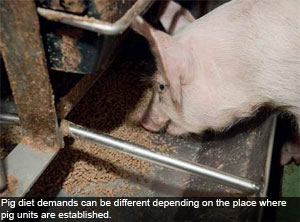Feeding the pig across the globe

Dietary requirements for pigs across the globe may vary depending on e.g. climate and latitude. This article attempts to provide some information on the nutrient specification of diets for pigs in selected countries. The information relates to large pig operations with more sophisticated systems of production run by producers with good technical knowledge.
By William H. Close, Close Consultancy, Wokingham, UK and Dr Jules Taylor-Pickard, Solutions Deployment Team Manager, Alltech
Although the practice of pig production varies from country to country, all producers are faced with the same key issues: to stay in business and be profitable. One of the major factors influencing the efficiency and cost of production is the cost of feed, which in many countries represents 60-70% of the total costs. Designing diets (and choosing appropriate ingredients) that meet the nutritional needs of the pigs at all stages of production, but without wastage, is therefore of paramount importance. In this respect, advances in our understanding of the nutritional physiology of the pig has allowed more precise definition of its nutritional needs over a wide range of circumstances as well as the development of feeding strategies that more exactly meet the animals’ needs.
Nutritional requirements
Considerable knowledge has been gained on energy, protein and amino acid metabolism and this has helped to define more precisely the energy and amino acid needs of pigs at all stages of production. This of course has been greatly facilitated by the use of simulation models which allow a wide variety of criteria to be considered. Examples of the energy and lysine requirements from the piglet (Table 2) and grow-finish pigs (Table 3) from recently published reviews are presented.
Knowledge of the animals’ nutrient requirements allows diets to be developed and formulated that match the animals needs and minimise the under- and over-supply of nutrients (Figure 1). This has been termed ‘phase feeding’ and its application has resulted in more efficient utilisation of feed, reduced excretion of surplus nutrients, especially nitrogen, phosphorus and trace elements into the environment, thereby minimising environmental pollution and, of course, reducing costs.
Global pig nutrition
An often asked question is: ‘How different are diets in their nutrient specification and how many are used for each stage of pig production and, indeed, do these vary across the major pig producing countries of the world?’ With a few examples from selected countries we will try to illustrate this for the piglet, the grow-finish pig and the breeding sow (Tables 1, 4 and 5).
In terms of energy, most diets are formulated in Digestible Energy (DE) or Metabolisable Energy (ME), although there is a current trend to formulate in Net Energy (NE), as it more closely matches the requirement of the animal. For each stage of production there are only minor differences in the dietary energy specification between countries.Lysine and amino acids are mainly expressed as total, even though it is generally recognised that ileal, or standard ileal digestible amino acids are more appropriate. Again, there are no big variations between countries.
In terms of minerals on the other hand, a wide range of inclusion rates was found for both macro and micro or trace minerals. Phosphorus is expressed in many countries as total, although it is recognised that digestible or available P takes account of the non-available phytate P. The inclusion rates of trace minerals, especially Cu and Zn, are confounded by the inclusion of therapeutic levels to enhance growth or control scouring, especially in piglets. For example in many countries it is quite common to add 150-200 ppm Cu from CuSO4 to enhance growth and 2-3 kg ZnO per tonne of feed (1,600-2,400 mg Zn/kg) to control scouring and diarrhoea in piglets. In the EU countries, the latter can only be provided through veterinary prescription; the maximum level of Cu in the diet of pigs up to ten weeks of age is also restricted to 160 mg Cu/kg and 25 mg/kg thereafter.
The form of the mineral, too, is important, and there has been a trend to include organic minerals, especially Se, instead of inorganic Se.
Akin to minerals, there is a wide range of inclusion rates of vitamins A, D, and E in all diets, with variations of up to two and three-fold in many cases. For example the variation in vitamin E was from a low of 10 IU/kg to a high of 120 IU/kg in grow-finish diets. However, higher than ‘requirement’ quantities may be added to boost health and immunity and to provide meat quality attributes (e.g. Selen-o-Pork).
Dietary ingredients
A range of ingredients are used to formulate diets, as indicated below:
Cereal sources: corn, wheat, barley, oats, sorghum, rye, rice, cassava, triticale
Protein sources: whey, milk by-products, soyabean meal, fish meal, potato meal, canola meal, lupins, beans, peas, sunflower meal, plasma, meal and bone meal, blood meal, yeast-derived proteins
Others: DDGS, wheat bran, wheat midlings, soya hulls, rice hulls, sugarbeet feed, bakery waste, alfalfa meal, tallow, vegetable oils, lactose, synthetic amino acids, additives
For piglets, the majority of diets contained processed cereals, high quality protein sources and milk products and by-products.
For grow-finish pigs conventional sources of cereals and proteins are included with smaller amounts of fibrous material.
For the sow, generally two or three diets are fed: one gestation diet and two lactation diets, depending upon feed intake (low or high). Generally these diets contain conventional cereal and protein sources with the addition of fats and oils in the lactation diets to enhance energy intake.
The gestation diet generally contains higher proportions of fibrous material to take account of the lower feed requirement, as well as the considerable fermentation capacity of the adult pig.











